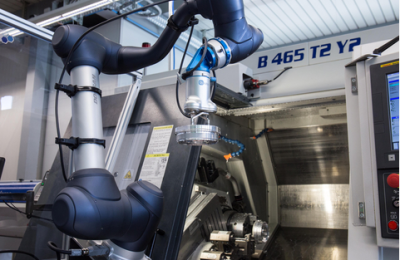
Attendees at IMTS in Chicago, September 12-17, were the first to experience what OnRobot has been preparing for years: the industry’s first automated, application- centered software platform for robotic deployment. D:PLOY is a turning point in OnRobot’s strategic evolution that began with its line of intuitive robotic tools and software, expanding the concept of collaborative automation. “The dramatic 80% reduction in deployment time is just one powerful illustration of what D:PLOY offers,” says Kristian Hulgard, General Manager of OnRobot’s Americas division. “Now system integrators can take on more projects with existing resources. Robot manufacturers benefit from dramatically greater accessibility for their products. And end users gain powerful new abilities to implement, manage, and redeploy automation across their facilities for long- term success.”
D:PLOY was previewed in a machine tending application at OnRobot’s IMTS booth #236254 using a UR5e from Universal Robots. The application demonstrates how the entire application, including any leading cobot or light industrial robot arm along with tooling, sensors, and other devices, is accessed and managed from D:PLOY’s dashboard. Users simply define the robot’s workspace with minimal inputs on points within the workspace, and enter attributes of the workpiece. D:PLOY automatically generates all the program logic, signal exchange, event handling, path planning, and real-time monitoring for the full application.
“D:PLOY is a foundational market shift that will change the way automation is deployed, expanding the market at the same time,” says Hulgard, who looks forward to presenting the first live demos at the show.
One System Solution laid the groundwork for expanding D:PLOY applications
At IMTS, users also got an up close and personal with the “One-System Solution” that laid the groundwork for D:PLOY by allowing any OnRobot end-of-arm tool (EOAT) to interface with any leading robot arm through a unified mechanical and electrical interface. At the OnRobot booth, visitors can choose between a range of EOAT and simply click the tools on and off a FANUC CRX robot arm equipped with OnRobot’s Quick Changer.
Visitors also experienced the new OnRobot Palletizer; a complete out-of-the-box, easy to program collaborative palletizing system. The OnRobot Palletizer is designed to take the pain out of palletizing processes through state-of-the-art hardware and software technology that will also launch as an application program available through the D:PLOY interface. At IMTS, the Palletizer is showcased in collaboration with OnRobot Partner Doig, featuring a Doosan M1013 robot.
Breadth of partnerships and compatibility on view in OnRobot booth
OnRobot partner Acieta also was at the OnRobot booth, showing how dual 3FG15 grippers take on a series of material handling and machine tending tasks, incorporating Acieta’s unique FastLOAD CX1000; an expandable cell for collaborative applications that can be moved and set up in minutes.
A press brake tending application in collaboration with OnRobot Partner EMI Corp demonstrated custom enhancements for OnRobot’s 3FG15, 2FG7 and VGC10 vacuum grippers. EMI designs and builds in-stock and custom solutions for OnRobot products, from 3D-printed vacuum tools to machined fingers for handling gripper.
OnRobot’s Screwdriver assembled aluminum cases for guitar pedals in an application handled by Kinovas’s Link 6 robot, showcasing how the Screwdriver’s precise torque control and intelligent error detection ensures quality and consistency.
“Entering our IMTS booth, the breadth of collaborative automation and compatibility of OnRobot is immediately apparent,” says Hulgard, emphasizing the many different robot brands and applications on display. “Our offerings and the way we will now unify them all through D:PLOY will help change how we think about collaborative automation, broadening its accessibility and improving success for manufacturers in almost any industry.”
Contact Details
Related Glossary Terms
- industrial robot
industrial robot
Robot designed for industrial use. Primarily used as a material-handling device but also used for changing tools, assembling parts, and manipulating special tools and measuring devices. Depending on design, an industrial robot can be programmed to perform a task by means of a controller, or it can be “walked” through the required movements by utilizing a digitizing system that translates movements into commands that the robot can be “taught.” See robot; teaching pendant.
- turning
turning
Workpiece is held in a chuck, mounted on a face plate or secured between centers and rotated while a cutting tool, normally a single-point tool, is fed into it along its periphery or across its end or face. Takes the form of straight turning (cutting along the periphery of the workpiece); taper turning (creating a taper); step turning (turning different-size diameters on the same work); chamfering (beveling an edge or shoulder); facing (cutting on an end); turning threads (usually external but can be internal); roughing (high-volume metal removal); and finishing (final light cuts). Performed on lathes, turning centers, chucking machines, automatic screw machines and similar machines.
